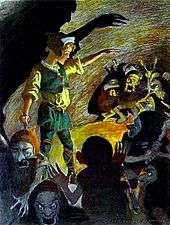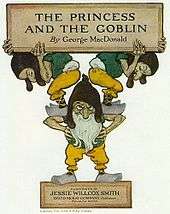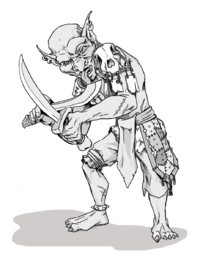Goblin
A goblin is a monstrous creature that appears in the folklore of multiple European cultures, first attested in stories from the Middle Ages. They are ascribed various and conflicting abilities, temperaments and appearances depending on the story and country of origin. They are almost always small and grotesque, mischievous or outright malicious, and greedy, especially for gold and jewelry. They often have magical abilities similar to a fairy or demon. Similar creatures include brownies, dwarfs, duendes, gnomes, imps, and kobolds.

Name
Alternative spellings include gobblin, gobeline, gobling, goblyn, goblino, and gobbelin. English goblin is first recorded in the 14th century and is probably from unattested Anglo-Norman *gobelin,[1] similar to Old French gobelin, already attested around 1195 in Ambroise of Normandy's Guerre sainte, and to Medieval Latin gobelinus in Orderic Vitalis before 1141,[2][3] which was the name of a devil or daemon haunting the country around Évreux, Normandy. It may be related both to German kobold and to Medieval Latin cabalus - or *gobalus, itself from Greek κόβαλος (kobalos), "rogue", "knave", "imp", "goblin".[2][4] Alternatively, it may be a diminutive or other derivative of the French proper name Gobel, more often Gobeau,[5][6] diminutive forms Gobelet, Goblin, Goblot, but their signification is probably "somebody who sells tumblers or beakers or cups".[7] Moreover, these proper names are not from Normandy, where the word gobelin, gobelinus first appears in the old documents. German Kobold contains the Germanic root kov- (Middle German Kobe "refuge, cavity", "hollow in a rock", Dial. English cove "hollow in a rock", English "sheltered recess on a coast", Old Norse kofi "hut, shed" ) which means originally a "hollow in the earth".[8][9] The word is probably related to Dial. Norman gobe "hollow in a cliff", with simple suffix -lin or double suffixation -el-in (cf. Norman surnames Beuzelin,[10] Gosselin,[11] Étancelin,[12] etc.) The Welsh coblyn, a type of knocker, derives from the Old French gobelin via the English goblin.[13][14] The term goblette has been used to refer to female goblins.[15][16]
Goblins in folklore


European folklore and collected folk stories
- A redcap is a type of goblin who dyes its hat in human blood in Anglo-Scottish border folklore.
- Hobgoblins are friendly trickster goblins from English, Scottish, and Pilgrim folklore and literature.
- The Benevolent Goblin, from Gesta Romanorum (England)[17]
- The Erlking is a malevolent goblin from German legend.
- The Trasgu is a Northern Spanish and Northern Portuguese mythological creature of Celtic and Roman origin.
- "The Goblin Pony", from The Grey Fairy Book (French fairy tale)
- "The Goblins at the Bath House" (Estonia), from A Book of Ghosts and Goblins (1969)
- "The Goblins Turned to Stone" (Dutch fairy tale).[18]
- King Gobb (Moldovan Gypsy folktale)
- Mill goblins appear in Norwegian folklore.
- Goblins are featured in the Danish fairy tales: The Elf Mound, The Goblin and the Grocer, and The Goblin and the Woman.
Goblin-like creatures in other cultures
- A pukwudgie is a type of goblin from Wamponoag folklore as well as Cryptozoology
- Muki (mythology) (Quechua for a goblin who lives in caves, also for asphyxia)
Many Asian lagyt creatures have been likened to, or translated as, goblins. Some examples for these:
- Chinese Ghouls and Goblins (England 1928)
- The Goblin of Adachigahara (Japanese fairy tale)[19]
- The Goblin Rat, from The Boy Who Drew Cats (Japanese fairy tale)
- Twenty-Two Goblins (Indian fairy tale)[20]
- In South Korea, goblins, known as dokkaebi (도깨비), are important creatures in folklore. They usually appear in children's books. The nursery song 'Mountain Goblin(산도깨비)' tells of meeting a goblin and running away to live.
- In Bangladesh, Santal people believe in gudrobonga which is very similar to goblins.
Other Goblins had been identified with creatures from another culture:
Goblins in modern fiction

Goblinoids are a category of humanoid legendary creatures related to the goblin. The term originated in the Dungeons & Dragons fantasy role-playing game,[22] in which goblins and related creatures are a staple of random encounters. Goblinoids are typically barbaric foes of the various human and "demi-human" races. Even though goblinoids in modern fantasy fiction are derived from J. R. R. Tolkien's orcs, in his Middle-earth "orc" and "goblin" were names for the same race of creatures.
In the Harry Potter book series and the shared universe in which its film adaptations are set, goblins are depicted as strange, but civilised, humanoids, who often serve as bankers or craftsmen.
The Green Goblin is a well-known supervillain who has various abilities like enhanced stamina, durability, agility, reflexes and superhuman strength due to ingesting a substance known as the "Goblin Formula". He has appeared in various Spider-Man related media, such as comics and films, including Spider-Man (2002) as Norman Osborn, and Spider-Man 3 (2007) and The Amazing Spider-Man 2 (2014) as Harry Osborn. The early Smurfs were called goblins.[23]
Goblin-related place names
- 'The Gap of Goeblin', a hole and tunnel in Mortain, France.[24]
- Goblin Combe, in north Somerset, UK
- Goblin Valley State Park, Utah, U.S.
- Goblin Crescent, Bryndwr, Christchurch, New Zealand
- Yester Castle (also known as "Goblin Hall") East Lothian, Scotland
- Goblin Bay, Beausoleil Island, Ontario, Canada
- Cowcaddens and Cowlairs, Glasgow, Scotland. 'Cow' is an old Scots word for Goblin, while 'cad' means 'nasty'. 'Dens' and 'lairs' refers to goblin homes.[25]
- 541132 Leleākūhonua (then known as 2015 TG387) is a minor planet in the outer solar system nicknamed "The Goblin"
References
- T. F. Hoad, English Etymology, Oxford University Press, p. 196b.
- CNRTL etymology of gobelin (online French)
- Du Cange et al, Glossarium mediae et infimae latinitatis ...(online French and Latin)
- κόβαλος, Henry George Liddell, Robert Scott, A Greek-English Lexicon, on Perseus
- Harper, Douglas. "Goblin". The Online Etymological Dictionary. Retrieved 2011-12-20.
- HOAD, p. 196b.
- Albert Dauzat, Noms et prénoms de France, Librairie Larousse 1980, édition revue et commentée par Marie-Thérèse Morlet. p. 295b Gobel.
- Duden, Herkunftswörterbuch : Etymologie der deutschen Sprache, Band 7, Dudenverlag, p. 359 : Kobel, koben, Kobold.
- HOAD, p. 101b.
- Géopatronyme : surname Beuzelin in France (online French)
- Géopatronyme : surname Gosselin in France (online French) Gosselin
- Géopatronyme : surname Étancelin in France (online French)
- Franklin, Anna (2002). "Goblin", The Illustrated Encyclopedia of Fairies. London: Paper Tiger. ISBN 1-84340-240-8. p. 108
- The Concise Oxford Dictionary of Current English
- Anthony, Piers (1992). The Color of Her Panties.
You can't move me out, you skirted goblette.
- Porter, Jesse (28 September 2015). "Goblin". The Adventures of Puss in Boots. Episode 12.
My dear, dear goblette, there is really nothing to it.
- Apples4theTeacher - short stories
- Dutch Fairy Tales for Young Folks, 1918, compiled by William Elliot Griffis
- Rick Walton - folktale
- Sacred texts
- Sally M. Promey Sensational Religion: Sensory Cultures in Material Practice Yale University Press, 2014 ISBN 9780300187359 pp. 99–100
- Weinstock, Jeffrey (2014). The Ashgate Encyclopedia of Literary and Cinematic Monsters. Ashgate Publishing, Ltd. ISBN 9781409425625.
- "9780854081530 - Dilly Duckling and the Goblins by Peyo; Matagne". www.biblio.com. Retrieved 2019-12-22.
- Ghosts, Goblins, and Haunted Castles, Aventinum Publishers, 1990 in English, page 51
- Glasgow Street Names, Carol Foreman, Birlinn, 2007, page 58.
Further reading
| Wikiquote has quotations related to: Goblin |
| Wikisource has original text related to this article: |
| Wikimedia Commons has media related to Goblins. |
- Briggs, K. M. (2003). The Anatomy of Puck. London: Routledge.
- Briggs, K. M. (1967). The Fairies in English Literature and Tradition. Chicago: Chicago University Press.
- Briggs, K. M. (1978). The Vanishing People. London: B.T. Batsford.
- Carryl, Charles E. (1884). Davy And The Goblin. Boston: Houghton Mifflin.
- Dubois, Pierre (2005). The Complete Encyclopedia of Elves, Goblins, and Other Little Creatures. New York: Abbeville Press. ISBN 0-789-20878-4.
- Froud, Brian (1996). The Goblin Companion. Atlanta: Turner.
- Froud, Brian (1983). Goblins!. New York: Macmillan.
- Page, Michael and Robert Ingpen (1987). British Goblins: Encyclopedia of Things That Never Were. New York: Viking.
- Purkiss, Diane (2001). At the Bottom of the Garden. New York: New York University Press.
- Rose, Carol (1996). Spirits, Fairies, Gnomes and Goblins: an Encyclopedia of the Little People. Santa Barbara, Calif.: ABC-CLIO.
- Sikes, Wirt (1973). British Goblins: Welsh Folk-lore, Fairy Mythology, Legends and Traditions. Wakefield: EP Pub.
- Silver, Carole G. (1999). Strange and Secret Peoples. Oxford: Oxford University Press.
- Zanger, Jules (1997). "Goblins, Morlocks, and Weasels". Children's Literature in Education. Oxford: Oxford University Press. 8: 154–162.